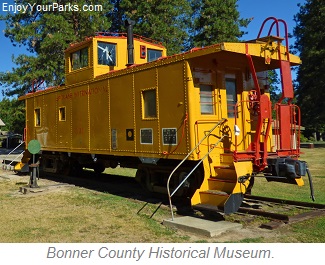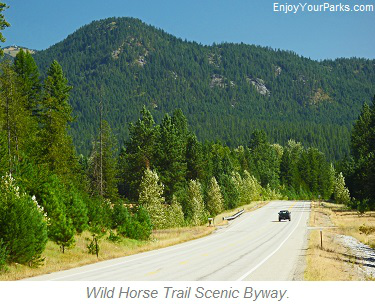Lake Pend Oreille Area
Includes Sandpoint Idaho, Pend Oreille National Scenic Byway,
Panhandle Historic Rivers Passage, Wild Horse Trail Scenic Byway, Priest Lake

Sandpoint Idaho along Lake Pend Oreille.
Lake Pend Oreille Area
Includes Sandpoint Idaho, Pend Oreille National Scenic Byway,
Panhandle Historic Rivers Passage, Wild Horse Trail Scenic Byway, Priest Lake

Lake Pend Oreille (pronouned "pond-der-ray") is located 60 miles north of Coeur d’Alene Idaho along Interstate 95, and is one of the top tourist destinations in Idaho. Being the largest lake in Idaho and surrounded by amazing scenery in all directions, Lake Pend Oreille is a fantastic place to visit, enjoy and explore during your Idaho vacation. There are many wonderful marinas, boat ramps and boat docks as Lake Pend Oreille is a water sport enthusiast’s dream come true. The main center of activity along the shores of Lake Pend Oreille is the tourist town of Sand Point Idaho.
Sandpoint Idaho is a charming town that offers everything a top-notch tourist town has to offer…great shopping, wonderful dining, terrific lodging and a seemingly endless list of things to do on and around the lake.

The bay at Sandpoint Idaho along Lake Pend Oreille is full of gorgeous boats.
About Lake Pend Oreille
 Lake Pend Oreille is not only the largest lake in Idaho (38th largest in the United States), but it is also one of the deepest lakes in the Rocky Mountain Region having a maximum depth of 1,150 feet. In fact, Lake Pend Oreille is the fifth deepest lake in the United States! This amazing lake has a surface area is 148 square miles, is 43 miles long and about 6 miles wide, and has 111 miles of shoreline.
Lake Pend Oreille is not only the largest lake in Idaho (38th largest in the United States), but it is also one of the deepest lakes in the Rocky Mountain Region having a maximum depth of 1,150 feet. In fact, Lake Pend Oreille is the fifth deepest lake in the United States! This amazing lake has a surface area is 148 square miles, is 43 miles long and about 6 miles wide, and has 111 miles of shoreline.
The shoreline of Lake Pend Oreille in Idaho has several outstanding marinas, camping areas, boat doats and ramps, as well as a few smaller yet quaint lake side towns that are fun to spend time at. Most of the Lake Pend Oreille shoreline however is completely non-populated, which adds to the beauty of this phenomenal lake.

Lake Pend Oreille is the fifth deepest lake in the United States.
Legendary Kamloops Trout
 In addition to the obvious water sport opportunities Lake Pend Oreille offers its visitors such as boating, sailing, water skiing, etc., Lake Pend Oreille is world famous for its Kamloop trout fishing. Kamloop rainbow trout are a specific strain that are native to the waters of British Columbia’s Lake Kootenay. This lake is near the town of Kamloops, which is where this trout species got its name. Kamloop trout were transplanted into Lake Pend Oreille from Kootenay Lake in the 1940s, and these trout thrived in the deep cold water of this northern Idaho Lake. Averaging about 6 to 8 pounds, Lake Pend Oreille Kamloop rainbow trout can grow to over 30 pounds! These giant trout are legendary in the world of fishing, and areamong the most famous trout found on the planet. You can talk to any trout fishing enthusiast around the country and around the world, and he/she will know about the Kamloop trout of Lake Pend Oreille.
In addition to the obvious water sport opportunities Lake Pend Oreille offers its visitors such as boating, sailing, water skiing, etc., Lake Pend Oreille is world famous for its Kamloop trout fishing. Kamloop rainbow trout are a specific strain that are native to the waters of British Columbia’s Lake Kootenay. This lake is near the town of Kamloops, which is where this trout species got its name. Kamloop trout were transplanted into Lake Pend Oreille from Kootenay Lake in the 1940s, and these trout thrived in the deep cold water of this northern Idaho Lake. Averaging about 6 to 8 pounds, Lake Pend Oreille Kamloop rainbow trout can grow to over 30 pounds! These giant trout are legendary in the world of fishing, and areamong the most famous trout found on the planet. You can talk to any trout fishing enthusiast around the country and around the world, and he/she will know about the Kamloop trout of Lake Pend Oreille.
Sandpoint Idaho
Sandpoint Idaho, with its population of only 7,400 people, is the major hub and tourist destination along the shores of Lake Pend Oreille of Northern Idaho. Sandpoint is a wonderful and charming lakeside town that is truly a "must see and explore" while in the Lake Pend Oreille area. Being a classic lakeside tourist town, Sandpoint Idaho offers its visitors splendid shopping, dining and lodging, as well as a fantastic beach and marina.
Sandpoint Idaho is the tourist hub of Lake Pend Oreille.

Boat Tours
Sandpoint Idaho provides visitors with some outstanding boat tours of Lake Pend Oreille. There are a number of options which include an old-style vessel and some newer boat designs. Visitors can also rent their own smaller boats for the day, as well as all the other water sport equipment one would need to enjoy Lake Pend Oreille.


Museums and Railroads
Sandpoint Idaho is regarded as one of the most important railroad towns in the entire West. Montana Rail Link, Spokane International Rail Systems and the Burlington Northern all converge at Sandpoint, creating what is known as "The Funnel. There are over 40 trains traveling through Sandpoint Idaho each and everyday, which has made this area a popular destination for railroad fans around the world. And having such a deep rooted railroad history, Sandpoint Idaho is home to the Bonner County Historical Museum, which highlights not only the railroad culture of area, but also the fur trading era, steamboat era, logging era, mining era and ranching era. The Bonner County Historical Museum is truly a "must see" if you're interested in the fascinating history of the Sandpoint / Lake Pend Oreille Area.



Sandpoint Idaho has a wonderful beach and marina where visitors can really enjoy Lake Pend Oreille!
Pend Oreille National Scenic Byway
 The Pend Oreille National Scenic Byway begins just north of Sandpoint Idaho at the junction of U.S. 95 and Idaho State Highway 200.
The Pend Oreille National Scenic Byway begins just north of Sandpoint Idaho at the junction of U.S. 95 and Idaho State Highway 200.
The Pend Oreille National Scenic Byway follows State Highway 200 around the
northern and eastern shoreline of Lake Pend Oreille and ends at the Montana State Line.
This amazingly scenic 34 mile scenic road provides outstanding views of Lake Pend Oreille via overlooks and turnouts along the highway, and there are several campgrounds and boat launches along the way as well.
The Pend Oreille National Scenic Byway also has fascinating interpretive displays along the byway, and we feel it's really a "must do" while visiting the Lake Pend Oreille Area as the views of the lake from this highway makes the drive in-and-of-itself worth your time.
Panhandle Historic Rivers Passage
Beginning at Sandpoint Idaho, the Panhandle Historic Rivers Passage follows U.S. Highway 2 to the Washington State Line. This 29 miles scenic byway follows the northern bank of the Pend Oreille River through the towns of Oldtown and Priest River. There are several scenic pullouts and turnouts, as well as interpretive displays along the Panhandle Historic Rivers Passage.
Wild Horse Trail Scenic Byway
 The Wild Horse Trail Scenic Byway, which is part of the International Selkirk Loop, begins along the northwest shore of Lake Pend Oreille at Sandpoint Idaho.
The Wild Horse Trail Scenic Byway, which is part of the International Selkirk Loop, begins along the northwest shore of Lake Pend Oreille at Sandpoint Idaho.
The 48 mile long Wild Horse Trail Scenic Byway follows the historic path of the Kootenai Tribe that led them to their fishing grounds at Lake Pend Oreille.
In 1808, the first white explorer by the name of David Thompson began using this trail, which then became even more utilized when gold was discoverered at Wild Horse Creek in the 1880s. Starting at downtown Sandpoint on U.S. Higway 95, the Wild Horse Trail Scenic Byway then heads northward on Idaho State Highway 1 through the town of Bonners Ferry, then all the way to the International Border Crossing at Porthill.
Priest Lake
 Priest Lake is located 64 miles north of Sand Point Idaho, and is an extremely popular destination for outdoor recreation enthusiasts who love boating, fishing, hiking and camping. To get to Priest Lake from Sandpoint Idaho, take U.S. Highway 2 westward until you reach the junction of State Highway 57. Take State 57 northward to Priest Lake.
Priest Lake is located 64 miles north of Sand Point Idaho, and is an extremely popular destination for outdoor recreation enthusiasts who love boating, fishing, hiking and camping. To get to Priest Lake from Sandpoint Idaho, take U.S. Highway 2 westward until you reach the junction of State Highway 57. Take State 57 northward to Priest Lake.
There are a number of large private resorts along Priest Lake, private homes, as well as numerous public campgrounds that include Indian Creek, Lionhead, Beaver Cree, Reeder Bay, Osprey, Outlet Bay and Luby Bay. There are boat launches available throughout the shoreline.
The largest town along Priest Lake is Coolin, which provides visitors with a marina and hotel. Priest Lake is actually two lakes: Upper Priest Lake and Lower Priest Lake (which is the primary lake), and these lakes are surrounded by gorgeous mountain scenery in all directions. Lower Priest Lake is about 19 miles long and has a maximum depth of 300 feet.

Priest Lake in Northern Idaho is a popular destination for outdoor enthusiasts of all kinds.
There is about a 2.5 mile thoroughfare between Lower Priest Lake and Upper Priest Lake, and the northernmost shoreline of Upper Priest Lake is only 15 miles from the Canadian Border. Priest Lake is a water sport enthusiasts dream come true, including fishing as Priest Lake is home to the largest lake trout ever caught in the United States at 57 pounds, 8 ounces in 1971.




